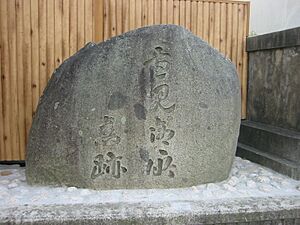Fukuhara-kyō facts for kids
Fukuhara-kyō (pronounced Foo-ka-ha-ra-kyo) was a very important city in Japan for a short time. It was the country's capital for about six months in the year 1180. This means it was where the Emperor and the government were located. Fukuhara-kyō was also the main base for a powerful leader named Taira no Kiyomori. It was where his special palace was located after he retired.
Contents
Kiyomori's Power Base
Fukuhara is now part of Kobe city in Japan. In 1160, it became the official home of Taira no Kiyomori. This happened after the Heiji Rebellion. In this war, Kiyomori's family, the Taira clan, defeated their rivals, the Minamoto clan.
Kiyomori became very powerful around this time. He was like the real leader of Japan, even though he wasn't the Emperor. He held this power until he died in 1181. In 1167, he was given the important title of Daijō Daijin (Chancellor). This was a very high government position. He also arranged for his daughter to marry into the Imperial family. This gave him even more influence over the Emperor and the government.
Kiyomori's Palace and Port
Kiyomori had a grand palace built for himself in Fukuhara. He also worked hard to improve the harbor there. He wanted to make trade easier in the Seto Inland Sea. This was part of his plan to expand Japan's trade.
Later, after an event called the Shishigatani Incident in 1177–1178, Kiyomori decided to retire. He moved to Fukuhara to distance himself from politics. He wanted to avoid the busy social life and official duties of the capital city.
Moving the Capital to Fukuhara
In June 1180, a big war began. It was called the Genpei War. The Minamoto clan started fighting against Kiyomori and his Taira clan. They were called to arms by Prince Mochihito.
After a battle at Uji, the head of the Minamoto clan, Minamoto no Yorimasa, was killed. Kiyomori then made a big decision. He arranged for the Imperial Court to move from Heian-kyō (which is now Kyoto) to Fukuhara.
Reasons for the Move
Kiyomori moved the capital for several reasons. He wanted to make sure he kept his power. He also wanted to watch the Emperor and the government more closely. This move allowed him to get directly involved in government matters again. It also helped protect the Emperors and the Court. They were safer from Kiyomori's enemies, the Minamoto clan and their allies.
The Imperial Procession
Soon after the battle, in June 1180, Kiyomori led a huge group of people to Fukuhara. This group included many nobles and government officials. It also included the young Emperor Antoku. Two former Emperors, Emperor Takakura and Emperor Go-Shirakawa, who had retired but still held influence (called cloistered emperors), also joined the procession.
Government offices were set up in fancy homes that belonged to members of the Taira clan. However, some government officials were not happy about this move. It caused a lot of problems and disruption. Many nobles also complained about the wet weather in the port city. They also disliked being so far from Heian-kyō. Because of these complaints, the Court moved back to Kyoto after about six months. Kiyomori followed them.
Fukuhara After the Capital Move
According to an old story called the Tale of Heike, the Taira clan (also called the Heike) stayed in Fukuhara for one night in 1183. They were retreating from battles at the time. When they left, they set fire to the imperial palace. The story says that leaving Fukuhara made them feel sad, even if it wasn't as painful as leaving the main capital.
Today, there are monuments that mark the places where Kiyomori's palace might have been. There are also markers for the Emperors' palaces and Kiyomori's tomb.
| Preceded by Heian-kyō |
Capital of Japan 1180 |
Succeeded by Heian-kyō |
See also
 In Spanish: Fukuhara-kyō para niños
In Spanish: Fukuhara-kyō para niños


